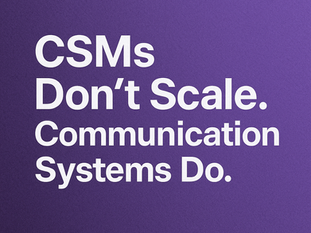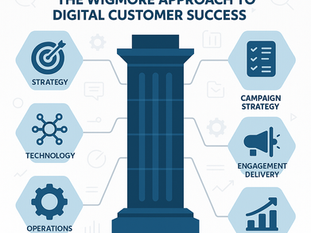
David Jackson
Co-Founder CLG Forum CEO, TheCustomer.Co

This is the third in a series of White Papers exploring concepts at the core of early stage B2B SaaS companies. In the first, Peter Lyon introduced Minimal Customer Value (MCV) as an alternative to Minimal Viable Product (MVP). Where MVP focuses on the minimum functionality needed, MCV focuses on the minimum value a customer must achieve. MVP is product and feature focused: MCV is customer value focused. In the second paper, Greg Daines set out how to set and deliver MCV. This, the third in the series, explores another core B2B SaaS concept; Product-Market Fit.
Product Market Fit
Product Market Fit is a rite of passage for SaaS companies. It's the point at which the product is seen to effectively solve a problem for a specific customer segment and can generate sustainable growth.
This is clear when the list of conditions most commentators use to judge the existence of PMF:
Strong customer retention and low churn rates
Increasing expansion revenue from existing customers
Sustainable customer acquisition costs (CAC)
Growing word-of-mouth referrals
Decreasing sales cycle length
Rising net revenue retention (NRR)
These are all very valid and important, but they share two characteristics:
They are all company financial metrics; none measure the benefits customers achieve.
They can only be measured after the fact, slowing down the speed of learning and experimentation.
For CLG companies, PMF has three core elements:

Product Results Fit: does the product measurably improve results that matter most to target customers?
Minimum Customer Value: what are the minimum results customers need to achieve to ensure retention?
GTM Fit: can we efficiently and reliably enable measurable results to attract, retain and grow chosen customers?
Minimum Customer Value has already been described. This white paper will focus on the role of Product Results Fit and GTM Fit in a future paper.
First principles
Before describing Product-Results Fit (PRF), it's necessary to understand the first principles thinking behind Customer-Led Growth (CLG).
Businesses buy software to address pain/gain points. They seek improvements in results that matter to them.
Measurable results, the real meaning of customer value, underpins effective customer acquisition, retention, expansion and advocacy.
The fundamental purpose of any B2B software business is therefore to deliver measurable results to its chosen customers in a way that drives profitable revenue.
CLG is a company-wide approach requiring alignment across the customer lifecycle and therefore involves all GTM teams, including product. Alignment delivers massive benefits.
GTM encompasses first sale, results (value) enablement, retention, expansion and advocacy.
Measurable results for chosen customers is the basis for alignment. That's what the company markets, what sales sell, what the product delivers and what services enable.
Alignment is achieved through building cross functional capabilities, common frameworks, metrics and collaboration. Organisation structure is secondary.
Introducing Product-Results Fit
Product-Results Fit is an assessment of how well the product you are building delivers the measurable results chosen customers buy your product to improve. Whereas Product-Market Fit is measured with lagging indicators about how the supplier is performing, Product-Results Fit is assessed primarily by leading indicators - the results customers achieve.
Product-Results Fit brings a number of advantages to Product-Market Fit:
It demands focus and greater understanding and clarity on how key roles in target customers measure the results your product delivers. This not only drives retention but helps the development of marketing and sales messaging.
It defines Minimum Viable Product in terms of the functionality needed to deliver Minimum Customer Value. Understanding the relationship between product functionality and the results that matter to customers focuses product development.
Customer results is a leading, not lagging indicator. It allows learning and adjustment earlier, thereby speeding up the process.
It does not exclude measures currently used to assess Product-Market Fit, it improves them by introducing leading indicators.
Elements of Product-Results Fit
These are the core elements of Product-Results Fit.
It begins with deep customer understanding; both the companies and key roles (personas) your product is designed to help. This is the basis of a customer resultsfocused value proposition. Product-Results Fit is therefore a test of that value proposition.
Clarity on the results that matter most to these companies and roles. This is a core part of a CLG Ideal Customer Profile, particularly the Role Profiles. A Role Profile focuses on the work a role has to do and how their performance is measured.
An understanding of how to measure these results. As Greg's paper describes, just measuring results improves the likelihood of renewal. Having a proven approach to measuring results makes quantifying value at the point of sale more robust, thereby improving the buyer's trust and increasing win rates.
Knowledge of what good results look like. This will differ based on the sophistication of customers: customers that are expert in the domain your product addresses will typically expect and achieve higher performance levels than novices.
The fit between the results that matter to customers and the functionality in your product. Customers don't care about your features per se, they care about how they enable them to do their jobs better and improve the results that matter to them.
This last point is at the heart of Product-Results Fit. The core question is how well does the product enable the results that matter to your chosen customer. If you cannot explain clearly how a feature enables a customer to achieve measurable results then either that feature is superfluous or your messaging is amiss.
(See the second white paper in this series "Quantifying Minimum Customer Value" by CLG Forum co-founder Greg Daines).
The Product-Results Fit matrix is a useful tool. It has a number of uses, which differ according to product maturity. As with all approaches used by customer-led growth companies, the starting point is the customer and working outside-in. The matrix (a table) begins with the results that matter to customers, specifically the key roles you sell to and serve. If the product serves multiple use cases, it is helpful to build a matrix for each use case. For most use cases, there are a limited number of results that really matter and a limited number of roles; stick to these. The other axis of the matrix lists the key features/ components. Again, stick to the core features.






